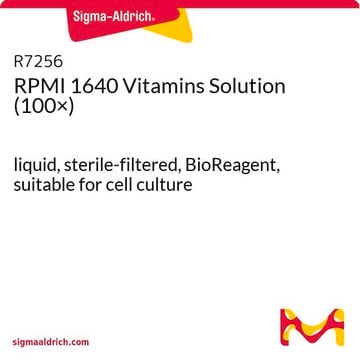M3817
MegaCell™ RPMI-1640 Medium
without L-glutamine, liquid, sterile-filtered, suitable for cell culture
Se connecterpour consulter vos tarifs contractuels et ceux de votre entreprise/organisme
About This Item
Code UNSPSC :
12352207
Nomenclature NACRES :
NA.75
Produits recommandés
Stérilité
sterile-filtered
Forme
liquid
Technique(s)
cell culture | mammalian: suitable
Impuretés
endotoxin, tested
Composants
L-glutamine: no
Conditions d'expédition
ambient
Température de stockage
2-8°C
Catégories apparentées
Description générale
MegaCell™ is a line of versatile media, formulated to significantly reduce the amount of serum required for cultivating mammalian cells in vitro. It is effective as a basal formulation for the growth and maintenance of adherent or suspension cell lines. When supplemented with 3% fetal bovine serum (FBS), MegaCell supports proliferative rates and maximal cell densities comparable, and in some cases superior, to the conventional basal formulation supplemented with 10% fetal bovine serum.
Application
MegaCell™ RPMI-1640 Medium has been used:
- as a component of the TSC medium for culturing trophoblast stem cells (TSC)
- as a component of 25 ng/ml FGF4 and 1 g/ml heparin (TSF4H medium) for culturing TSCs
- as a component of embryo-like structures (ETS) embryo medium and TS cell medium for culturing embryonic stem cells (ESCs) and TSCs
Reconstitution
Supplement with 4 mM L-glutamine (20 ml of 200 mM solution, G7513)
Informations légales
Sigma-Aldrich uses the MegaCell trademark pursuant to an agreement with Promega Corporation.
MegaCell is a trademark of Promega Corp.
Souvent commandé avec ce produit
Réf. du produit
Description
Tarif
Code de la classe de stockage
10 - Combustible liquids
Classe de danger pour l'eau (WGK)
WGK 3
Point d'éclair (°F)
Not applicable
Point d'éclair (°C)
Not applicable
Certificats d'analyse (COA)
Recherchez un Certificats d'analyse (COA) en saisissant le numéro de lot du produit. Les numéros de lot figurent sur l'étiquette du produit après les mots "Lot" ou "Batch".
Déjà en possession de ce produit ?
Retrouvez la documentation relative aux produits que vous avez récemment achetés dans la Bibliothèque de documents.
Les clients ont également consulté
Sarah Ellys Harrison et al.
Nature protocols, 13(7), 1586-1602 (2018-07-11)
Mammalian embryogenesis requires the coordination of embryonic and extra-embryonic tissues to enable implantation into the uterus and post-implantation development to establish the body plan. Mouse embryonic stem cells (ESCs) are a useful tool for studying pluripotent embryonic tissue in vitro.
Nina S Corsini et al.
Cell stem cell, 22(4), 543-558 (2018-04-07)
Stem cell-specific transcriptional networks are well known to control pluripotency, but constitutive cellular processes such as mRNA splicing and protein synthesis can add complex layers of regulation with poorly understood effects on cell-fate decisions. Here, we show that the RNA
Berna Sozen et al.
Developmental cell, 51(6), 698-712 (2019-12-18)
Mammalian blastocysts comprise three distinct cell lineages essential for development beyond implantation: the pluripotent epiblast, which generates the future embryo, and surrounding it the extra-embryonic primitive endoderm and the trophectoderm tissues. Embryonic stem cells can reintegrate into embryogenesis but contribute
Jinhong Meng et al.
PloS one, 6(3), e17454-e17454 (2011-03-17)
Stem cell transplantation is a promising potential therapy for muscular dystrophies, but for this purpose, the cells need to be systemically-deliverable, give rise to many muscle fibres and functionally reconstitute the satellite cell niche in the majority of the patient's
Notre équipe de scientifiques dispose d'une expérience dans tous les secteurs de la recherche, notamment en sciences de la vie, science des matériaux, synthèse chimique, chromatographie, analyse et dans de nombreux autres domaines..
Contacter notre Service technique





